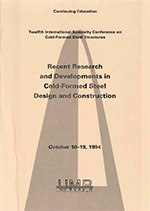Location
Saint Louis, Missouri
Session Dates
18 Oct 1994
Abstract
Hydro-electric transmission towers are traditionally built using hot-rolled angles. However cold formed angles are becoming more popular as replacements for hot-rolled angles, especially in the smaller angle sizes. In addition to conventional 90° angles, a wide range of shapes can be produced, in sizes to suit individual project requirements. In particular, cold-forming can be used to provide stiffening lips to prevent local buckling of thin wide elements, to optimize shapes so that longer unbraced lengths can be used, and to create shapes such as 60° angles for triangular towers. A research project was carried out at the University of Manitoba to examine the axial compressive load capacity of a number of cold-formed shapes suitable for transmission tower construction. Test parameters included: five different cross-sections, two steel grades, three different slenderness ratios, and three temperature levels. Specimens were tested in setups designed to simulate end conditions representative of actual web members by loading through single legs bolted to gusset plates. A number of specimens were loaded concentrically with hinged end conditions. Three special test setups were constructed to accommodate the wide range of sections, which varied from 552 mm to 8200 mm in length. A total of 189 static tests were performed. Test results were compared to ultimate loads obtained from the Canadian Standards such as CAN/CSA-S136-M89, Cold Formed Steel Structural Members, and CAN/CSA-S37-M86, Antennas, Towers, and Antenna Supporting Structures, as well as to loads predicted by the ASCE Manual 52, Guide for Design of Steel Transmission Towers, and the ECCS Recommendations for Angles in Lattice Transmission Towers.
Department(s)
Civil, Architectural and Environmental Engineering
Research Center/Lab(s)
Wei-Wen Yu Center for Cold-Formed Steel Structures
Meeting Name
12th International Specialty Conference on Cold-Formed Steel Structures
Publisher
University of Missouri--Rolla
Document Version
Final Version
Rights
© 1994 University of Missouri--Rolla, All rights reserved.
Document Type
Article - Conference proceedings
File Type
text
Language
English
Recommended Citation
Odaisky, David; Polyzios, Dimos; and Morris, Glenn, "Cold-formed Steel Sections for Transmission Towers" (1994). CCFSS Proceedings of International Specialty Conference on Cold-Formed Steel Structures (1971 - 2018). 3.
https://scholarsmine.mst.edu/isccss/12iccfss/12iccfss-session5/3
Cold-formed Steel Sections for Transmission Towers
Saint Louis, Missouri
Hydro-electric transmission towers are traditionally built using hot-rolled angles. However cold formed angles are becoming more popular as replacements for hot-rolled angles, especially in the smaller angle sizes. In addition to conventional 90° angles, a wide range of shapes can be produced, in sizes to suit individual project requirements. In particular, cold-forming can be used to provide stiffening lips to prevent local buckling of thin wide elements, to optimize shapes so that longer unbraced lengths can be used, and to create shapes such as 60° angles for triangular towers. A research project was carried out at the University of Manitoba to examine the axial compressive load capacity of a number of cold-formed shapes suitable for transmission tower construction. Test parameters included: five different cross-sections, two steel grades, three different slenderness ratios, and three temperature levels. Specimens were tested in setups designed to simulate end conditions representative of actual web members by loading through single legs bolted to gusset plates. A number of specimens were loaded concentrically with hinged end conditions. Three special test setups were constructed to accommodate the wide range of sections, which varied from 552 mm to 8200 mm in length. A total of 189 static tests were performed. Test results were compared to ultimate loads obtained from the Canadian Standards such as CAN/CSA-S136-M89, Cold Formed Steel Structural Members, and CAN/CSA-S37-M86, Antennas, Towers, and Antenna Supporting Structures, as well as to loads predicted by the ASCE Manual 52, Guide for Design of Steel Transmission Towers, and the ECCS Recommendations for Angles in Lattice Transmission Towers.



